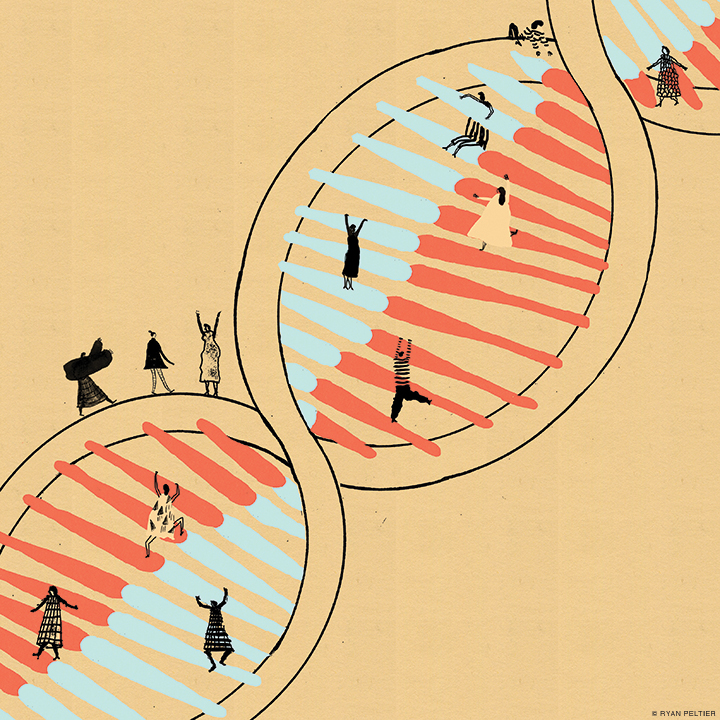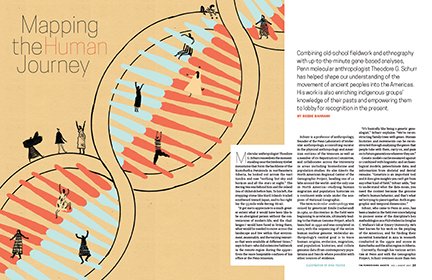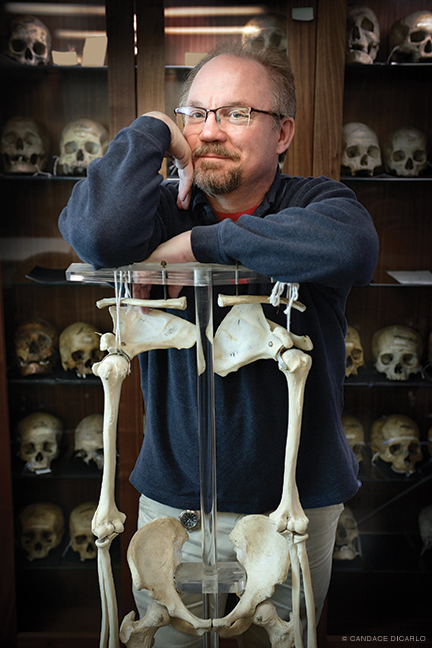
Combining old-school fieldwork and ethnography with up-to-the-minute gene-based analyses, Penn molecular anthropologist Theodore G. Schurr has helped shape our understanding of the movement of ancient peoples into the Americas. His work is also enriching indigenous groups’ knowledge of their pasts and empowering them to lobby for recognition in the present.
BY BEEBE BAHRAMI | Illustration by Ryan Peltier

Molecular anthropologist Theodore G. Schurr remembers the moment: standing near the Sredinny Krebet mountains that form the backbone of the Kamchatka Peninsula in northeastern Siberia, he looked out across the vast tundra and saw “nothing but sky and horizon and all the stars at night.” The Bering Sea was behind him and the inland Sea of Okhotsk before him. To his left, the stepping-stone-like Kuril Islands trailed southward toward Japan, and to his right lay the 55-mile wide Bering Strait.
“It got me to appreciate to a much greater extent what it would have been like to be an aboriginal person without the conveniences of modern life, and the challenges I would have faced in living there, what would be needed to move across the landscape and live within that environment, seasonality, and the varying resources that were available at different times,” says Schurr—who did extensive fieldwork in the remote region during the 1990s—from the more hospitable confines of his office at the Penn Museum.
Schurr is a professor of anthropology, founder of the Penn Laboratory of Molecular Anthropology, a consulting curator in the physical anthropology and American sections of the Museum as well as a member of its Repatriation Committee, and collaborates across the University in areas including biomedicine and population studies. He also directs the North American Regional Center of the Genographic Project, heading one of 12 labs around the world—and the only one in North America—studying human migration and population histories on a continent-wide scale under the auspices of National Geographic.
The term molecular anthropology was coined by geneticist Emile Zuckerandl in 1962, as discoveries in the field were beginning to accelerate, ultimately leading to the Human Genome Project, which launched in 1990 and was completed in 2003 with the sequencing of the entire human nuclear genome. Molecular anthropology’s central goal is to trace human origins, evolution, migration, and population histories, and collate genomic data (from contemporary populations and fossils where possible) with other sources of evidence.
“It’s basically like being a genetic genealogist,” Schurr explains. “We’re reconstructing family trees with genes. Human histories and movements can be reconstructed through analyzing the genes that people take with them, carry on, and pass on to future generations wherever they are.”
Genetic models can be measured against or combined with linguistic and archaeological models, paleoclimate data, and information from skeletal and dental remains. “Genetics is an important tool and it does give insights you can’t get from any other kind of field,” Schurr adds, “but to understand what the data mean, you need the context because the genome reflects human behavior, and that’s what we’re trying to piece together. Both in geographic and temporal dimensions.”
Schurr, who came to Penn in 2001, has been a leader in the field ever since helping to pioneer some of the discipline’s key methodologies as a PhD student in Douglas C. Wallace’s lab at Emory University. He’s best known for his work on the peopling of the Americas, and for finding their ancestral homeland in Asia in research conducted in the 1990s and 2000s in Kamchatka and the Altai region in Siberia.
Currently, through his various activities at Penn and with the Genographic Project, Schurr oversees more than two dozen projects around the globe. When I asked him to mark on a map everywhere he has worked, a mosaic of circles appeared in the South Pacific, Australia, Southeast Asia, South Asia, parts of sub-Saharan Africa, and multiple spots in the Arctic, the Caribbean, and Central and South America.
Migratory Route
Schurr’s own journey started in rural Ohio, where he grew up. Both of his parents were biologists, and from early childhood he had a strong interest in that subject as well as history. He and his sisters grew up camping, exploring, and traveling near and far with parents who pointed out natural and social wonders along the way. These trips, he says, forged a curiosity about the world and an ease within it.
As an undergraduate at the University of Georgia, Schurr sampled topics from communist China to limnology (the study of fresh water lakes and rivers) in his classes. It wasn’t until his senior year that he found his academic Rosetta Stone: “an anthropology course on native history and the history of Ponce de Leon invading Florida and the damage wreaked as a consequence.” That class, he says, “got me thinking about how one could do research that had both a biological-evolutionary and also a social science dimension.”
After graduation, Schurr worked in a plant-genetics lab at the university, learning the new molecular techniques emerging in the 1980s. He also became interested in the work that phylogeographer John Avise was doing there, mapping the relationship between species, their evolution and geographic distribution using mitochondrial DNA (mtDNA). It was Avise who directed him to Wallace’s lab in Emory’s Center of Molecular Medicine, which was known for its pioneering work on human mtDNA.
(Wallace is now also at Penn, where he holds the Michael and Charles Barnett Endowed Chair in Pediatric Mitochondrial Medicine and Metabolic Disease, and directs the Center for Mitochondrial and Epigenomic Medicine at the Children’s Hospital of Philadelphia.)
Wallace, Schurr, and their colleagues at Emory mapped mtDNA variation by using indigenous populations that were well-defined and could offer the oldest variations of different maternal lineages (mtDNA is transmitted from mothers to children).
Since mtDNA is simply replicated from generation to generation, the only changes that occur are the result of mutations. Calculating the rate of mutation makes it possible to create a molecular clock to track mutations from oldest to youngest, and reconstruct the temporal progression of lineages from Africa to later offshoots in Eurasia and Australo-Melanesia and onward into the Americas.
According to Wallace, the Emory lab’s concentration on well-defined indigenous populations distinguishes their approach from that taken in a 1987 paper by UC Berkeley researchers Rebecca Cann, Mark Stoneking, and Allan Wilson. Sampling the mtDNA of 147 people around the world, they showed that they all shared ancestry in a single lineage that lived in Africa around 200,000 years ago. While the conclusion that human mtDNA lineage originated in Africa was true, their data was confounded by the inclusion of African Americans—whose genetic background would also include Americans of European and Asian-Native American ancestry—in their “African” sample.
The Emory researchers, by contrast, were able to show that “indigenous African mtDNAs are distinct from Eurasian and Native American mtDNAs. The African lineages are more diverse, demonstrating that they are older, confirming the African origin of human mtDNAs,” Wallace explains. “We specifically strove to avoid studies of populations with recent admixture. For this reason, it is the nomenclature and geographic radiation of mtDNAs that we developed while Dr. Schurr was a graduate student that is the basis of all subsequent studies on mtDNA radiation and disease.”
Schurr has continued this work in his own lab at Penn. He also works with the whole human genome, though mtDNA and Y-chromosome DNA (the latter of which is passed from fathers to sons) remain the pillars of studying maternal and paternal lineages.
These different lineages are also known as haplogroups. We all carry some sublineage of the oldest lineages originating in Africa (collectively belonging to macrohaplogroup L). But as our ancestors began migrating beyond the mother continent, these lineages split off and formed new founding lineages (macrohaplogroups M, N, and R), carrying the old markers but adding new ones unique to each (with more numbers and letters added to subclassify lineages within these macro-lineages, such as F, G, and H, and so forth).
They found that Native Americans have five unique lineages and anyone carrying them was related to these first peoples who colonized the New World. These lineages at their broadest notation are known as A, B, C, D, and X. The first four are found across the Americas, and the fifth only in North America.

Coming to America
“For much of its history, the Kamchatka Peninsula in remote northeastern Russia has remained largely unknown to the outside world,” Schurr wrote in an article for the Museum’s magazine, Expedition, in 2002, describing his fieldwork there in 1993 and 1996. Though Russians had first arrived in the area in the mid-1600s and maintained a presence thereafter, “no one knew much about its geographic relationship to the rest of the world,” he added.
This outpost in northeast Siberia was viewed as among the most likely places to look for the ancestral home of Native Americans who first crossed what is now the Bering Strait but then was the land-bridge known as Beringia linking Russia and North America. Located along the farthest edge of Asia where it meets the Bering Sea, the area is famous for its landscape of volcanic peaks jutting through thick banks of fog, and thousands of rivers that run off into seemingly endless, maze-like valleys. The only way to most villages is by helicopter—unless you want to walk like the nomads of old. Since the end of the Soviet Union in 1991 and the opening of Russia, tourism has been growing and may dramatically alter the landscape on many levels. But it remains a world that still subsists largely on salmon fishing and reindeer herding.
Schurr worked with Rem Sukernik and Elena Starikovskaya of the Institute of Cytology and Genetics in Novosibirsk, Russia, and members of the two main indigenous populations, the Koryaks and Itel’men. Their research expanded understanding of both the older and more recent human stories, including how those groups were related to other contemporary native northeast Asians, such as the nearby Chukchi, Evens, Yakuts, and Ainu. Their fieldwork also focused on the impact of Russian colonization, warfare, and disease on the native populations.
Genetic testing of the Koryaks and Itel’men participants showed that they were not closely related enough to Native Americans to identify northeast Siberia as the ancestral homeland, but they were closely related to East Asians and eastern Siberians. The results also indicated that the ancestors of these indigenous groups probably expanded into Kamchatka relatively recently, around 6,000 to 8,000 years ago, and that they may also have absorbed the earlier populations there whose relations had already crossed into the Alaskan side of Beringia. These were important findings in themselves, but the quest for the ancestral place of origins for Native Americans persisted.
Schurr sought it deeper in Asia.
Asia is the largest continent, and yet it has some sweeping unifying qualities, one being a vast continuous stretch of grassland reaching 5,000 miles from northeastern China to Hungary. The Altai region is right in the middle of this Steppe-belt between East and West Asia, in southern Siberia at the intersection of borders with Russia, Mongolia, China, and Kazakhstan.
“It’s a very productive area,” Schurr says. “It’s mountainous, but it has a lot of rivers, forests, and wildlife. It can be very cold in the winter but also very warm and productive in the summer. It also connects along the Steppe belt that extends across much of Eurasia, so it’s an area people would have been able to use in different weather and different terrains in different areas and not have to go into colder and harsher areas as an initial potential dispersal pattern.”
Archaeological evidence indicates that humans have lived in the Altai for 30,000 to 40,000 years. Linguistic and ethnographic data additionally imply that indigenous Siberians may have originated here. Taking these as encouraging indications and building on ongoing work in his lab to further discern founding Native American maternal and paternal lineages, in 2003 Schurr began work in the Altai-Sayan regions in collaboration with Russian colleague Ludmila Osipova and several graduate students over the following years. Local participants included indigenous Chelkan, Tubular, Kumandin, and Altaian Kazakhs in the north, and indigenous Altai-kizki in the south.
The comparative genomic data from Schurr and his team’s efforts showed a strong connection between southern Altaians and Native Americans and indicated that they shared a common ancestor among those ancient peoples who were the earliest settlers in the region.
Then, around 20,000 to 25,000 years ago, their descendants moved from the Altai into Beringia and settled there for several millennia, at which point—15,000 to 20,000 years ago—some of this founding Beringian group’s descendants ventured into the Americas. It was a single and significant migration that gave its unique lineages, maternal and paternal, to all Amerindians, north, central, and south.
That first migration very likely used the coastal pathways and moved along the Pacific shore. This route would have been rich in nutritious kelp, fish, sea mammals, and shellfish, with access to many rivers carrying fresh water and rich in other food sources. These people and their descendants gradually made their ways across the Americas and to the southernmost tip of Argentina. Over the millennia, these populations diversified in their own regions.
Earlier estimates had put the arrival of the first Americans at around 13,000 years ago. Schurr’s work helped push the date of that first crossing back by several millennia, as well as showing that all it took was one crossing to make an impact on all the Americas. The 14,500-year-old site of Monte Verde in southern Chile, along with several other recent archaeological discoveries, also confirm older dates than the original estimates.
Analysis of all the genetic lineage data showed that 8,000 to 10,000 years ago a second major migration occurred, also emanating from Beringia, and brought over the ancestors of North America’s Eskimo-Aleuts and Athabaskan (Na-Dene) peoples. These findings confirmed already existing archaeological, linguistic, and ethnographic evidence and gave more detail about population dynamics to the whole story.
The team also discovered that ancient Altaians were not only the founding populations that seeded the Americas, but that their lineages also appear in contemporary Japanese, Koreans, and possibly Tibetans. Altaians also show much more recent ancestry connected to Turkic (and Mongolic) speakers who spread west across Asia in migrations and conquests as far as Anatolia over the past 2,000 years. This confirmed another story, that the Altai was the mythic homeland of the Turks, a strong national narrative in circulation in today’s Turkey. However, later research out of Schurr’s lab by Omer Gokcumen Gr’08 provided a more nuanced picture.
Schurr has “always been a leader in our understanding of the Americas—where exactly the ancestral populations were before they went into the Americas and how that migration spread,” says Gokcumen. “But he also has been pretty influential in getting samples [from all over the world] and making relatively enigmatic relations we wouldn’t [otherwise] know.” In addition to his own scholarly contributions, Gokcumen adds, Schurr also has made a significant impact in mentoring students. “People such as myself—he gave me the freedom to pursue my own interests.”
Currently Gokcumen is an assistant professor in the Department of Biological Sciences at SUNY Buffalo, where his research lab studies the interbreeding of Homo sapiens with Neandertals during their respective Eurasian migrations anywhere from 110,000 to 45,000 years ago. But when he came to Penn in 2002 to work with Schurr, he wanted to study genetic variation in Turkey and connect it to bigger historical events, such as the Turkic speakers who came into Turkey from Central Asia.
Schurr first set him to work in the lab on the Altaian material, and when it came time to do fieldwork, Gokcumen conducted an ethnohistorical survey of areas of eastern and central Turkey. He visited some 50 villages, of which Schurr joined him on about 20.
By the time Gokcumen was done with the survey, he found Turkey to be such an overwhelmingly diverse place that he set his focus on a smaller sampling, a handful of neighboring villages. Villages are “essentially the natural social unit,” Gokcumen notes. It had become clear that despite the nationalist idea of all people in Turkey being Turks, a unified solid-colored tapestry, they were in fact a riotous multicolored mosaic. Each village defined its primary identities—religious, ethnic, tribal, or geographic origin—differently from even its neighbors.
Social distinctions were reflected in the genetic results. Each village had a distinct paternal lineage, with more diverse maternal lineages (women married in from the outside and men stayed in the village). It reinforced both the identity choices in each village, plus the importance of patrilocality in all of them.
“Every genetic history is guided by the non-genetic evidence,” says Schurr. “Such as the vast historical and Ottoman documents available to look at past population dynamics of a diverse empire, or accounts of the migrations and incursions of the Turks from Central Asia in the 11th century, or the Mongol invasion in the 13th. But the records can’t convey who exactly are the Turks today. [Genetics] can add complexity to models of ancestry and origins that are already in place.”
Incredible Diversity, Profound Alterations
Geneticist Spencer Wells, the mastermind behind National Geographic’s Genographic Project, was aware of Schurr’s work in Siberia and the Americas and recruited him to the project in 2005. According to the project’s website, this team is made up of “renowned scientists [who] are using cutting-edge genetic and computational technologies to analyze historical patterns in DNA from participants around the world to better understand our shared genetic roots.”
With funding from National Geographic, IBM, and the Waitt Family, from 2005 to 2012 the team implemented phase 1, “a lot of fieldwork and working with a variety of indigenous populations from around the world,” Schurr says. In the second phase, which is ongoing, the 12 labs involved—which must now underwrite their own activities—continue to do field and lab work, publish and communicate with stakeholders and the public, and expand their analysis of the vast (and growing) material on hand.
In 2013 project participants developed and began applying a biochip called the GenoChip, a microarray of markers from all parts of human DNA that are screened as “Ancestry Informative Markers” (AIM). The GenoChip is the first array developed strictly for genetic anthropological research and contain no markers that could be ethically compromising by including health, medical, or phenotype-related information. The 2015 version includes more than 750,000 markers that uniquely filter for lineage and population ancestry and has fine-tuned the ability to determine and map individual and population histories.
Schurr’s main efforts in the project are to reconstruct the indigenous history of the Americas, from Canada, Alaska, and the rest of the United States, “as well as with dozens of indigenous groups in Mexico and indigenous-derived communities in the Caribbean,” he says.
One recent highlight was among the Haida and the Tlingit of southeast Alaska. Both groups are organized by traditional matrilocal and matrilineal clans and a comparison of clan, linguistic, and other cultural evidence with the mtDNA and Y-chromosome DNA results from both populations showed a near-perfect match to their social practices.
“The matrilineal clan ancestry that’s passed down from mothers to their offspring, and is inherited through women vis-à-vis clan status, was linked to mitochondrial data,” Schurr says. “We could show that people who belonged to the Raven Clan had certain mtDNA types; those who were Eagle Clan had different types.”
While not absolute, the evidence is “pretty clear that they actually are distinct. And because they are self-identified that way, and they married that way despite all the changes in the past century or two, we saw the legacy of that whole cultural pattern that existed for a long time,” he adds. “This was actually relatively exciting to both us and the communities themselves.”
Schurr works closely with Professor Fabricio R. Santos of Brazil’s Universidade Federal de Minas Gerais, coordinator of the Genographic Project in South America, to coordinate complementary projects in North, Central, and South America. “Our goals are to increase knowledge about Native American history in both continents, with standardized methodologies that use genetics for the reconstruction of past migrations, demography, and other historical events,” Santos explains.
A key beneficiary of such studies, he adds, “are the indigenous people, who can be part of historical books as more details can be added to their past through scientific disciplines like archaeology, historical genetics, physical anthropology, linguistics, et cetera.
“Dr. Schurr brought this differential approach to North America, where the laboratory work was also accompanied by field work that included a true co-participation of indigenous communities in this initiative, which is not a common approach in genetic research. He was always dedicated and concerned about the methodological and ethical aspects of the research.”
All the programs Schurr directs emphasize open communication, disclosure, and information-sharing. From the participants who contribute their life histories and blood samples, to the local leaders and administrative officials, to collaborating researchers and students, everyone is an equal stakeholder and partner in the research. Each project involves many conversations and trips before and during the research process, and afterward to return results and knowledge to participants and their communities.
“We go together with people who are helping us collect the samples,” Schurr details, “but [also] work with local people. In some places, we can speak the languages. In other cases, we work with people who have to translate for us or who are bi- or tri-lingual themselves. We meet with people ahead of time—community leaders—and often we get approval to work in those places. Sometimes we have to have tribal or local approval before we even go to those places.”
Though unified by that first migration more than 15 millennia ago, each part of the Americas is now incredibly diverse and complex, as well as profoundly altered by the past 500 years of European contact, conquest, disease, and exploitation. Yet the deeper past persists in indigenous cultures, languages, local histories, and genes.
Schurr and colleagues’ efforts in the Caribbean—the first place of European contact that experienced unprecedented social and cultural destruction—have brought surprising stories to light. They show that the ethnic diversity of the pre-Columbian peoples is still present in the population, and also offer tangible evidence in support of native peoples pressing for official recognition after centuries of injustice and invisibility.
In Puerto Rico, work on the eastern part of the main island and on Vieques Island explored the islanders’ ties to the ancestral Taíno peoples who once lived there. The contemporary Naguake Community resides in eastern Puerto Rico and is seeking official recognition as an indigenous community. The Arawak and Taíno languages are now taught in local schools.
Schurr and his colleagues found that between 60 and 65 percent of all Puerto Ricans have Native American maternal lineages—a remarkable percentage after 500 years of disruption, and one confirming that this aspect of the Taíno lineage has survived. Results from the paternal side—which, by contrast, showed no indigenous ancestry but strong European, North African, and sub-Saharan African lineages—spoke to the fact that the conquerors were male. Screening for Native American ancestry on autosomal DNA, the nuclear DNA inherited from both parents, revealed at least 10 to 20 percent native ancestry coming from both sides.
The Naguake Community was excited to learn they still had a robust connection to their ancestors. Schurr clearly enjoys this part of the process: returning to the communities to report the findings and passing along the knowledge to the most important stakeholders in the unfolding story.
In the Lesser Antilles, the team focused on the Garifuna Community of St. Vincent and the Santa Rosa First People’s Community of Trinidad, where it was found that both groups had up to 45 percent indigenous maternal lineages but with varying degrees of association with different Native American lineages. This reinforced the idea that the peoples of the Caribbean were already quite diverse before contact with Europeans. Historical documents indicate that there may have been as many as eight distinct ethnic groups in the Caribbean—a legacy soon shattered by disease, genocide, slavery, and colonization after contact. But the traces of that earlier past were discovered in the DNA analysis; markers for paternal indigenous lineages hinted at a different story of persistence among male ancestors in the face of conquest. Such efforts to reconstruct past human histories are helping contemporary peoples to reclaim their ancestries, legacies, stories, histories, languages, cultures, official status, and lands.
All ethnographies are concerned with genealogies. “Genealogies and kin terms are the mainstay of cultural anthropology, and how those social facts shape human relationships,” says Schurr, explaining the importance of identity and origins to peoples around the globe. “It’s something everyone knows about: [these facts] shape lives, inform decisions about marital partners, who you do business with, and your obligation to kin. Beyond that, people also recognize that they behave like Uncle Ted or they understand they look like certain family members.
“We’re social creatures; we live in a social nexus,” he adds. “It’s an essential part of who we are. We all care about where we came from and who our ancestors are. We have histories that are built around family and social interactions.”
Beebe Bahrami Gr’95 is the author of two recent books, the travel memoir Café Oc, and an archaeological adventure and scientific inquiry into the Neandertals, Café Neandertal. Both map a journey through southwestern France and northern Spain.




